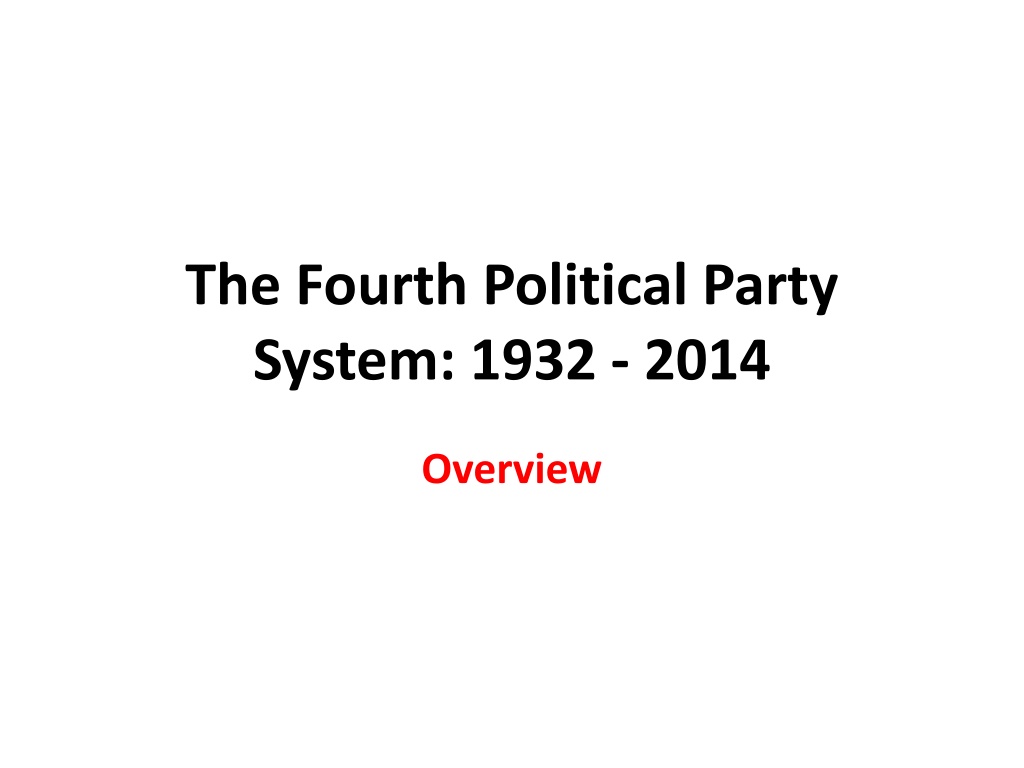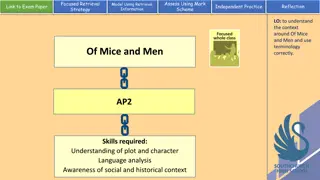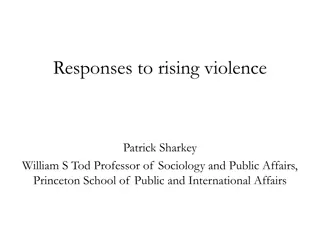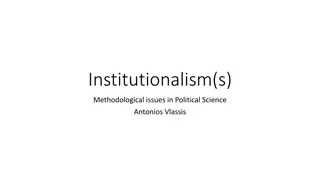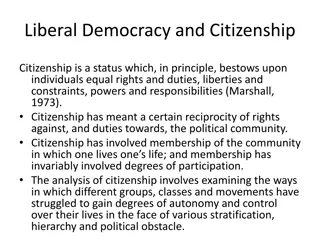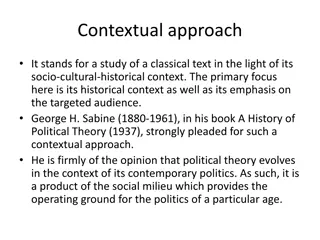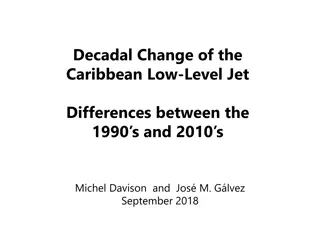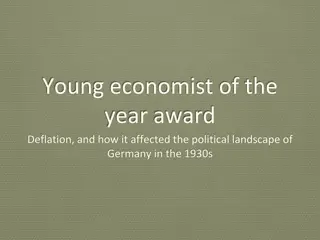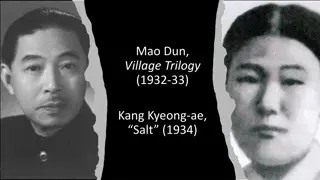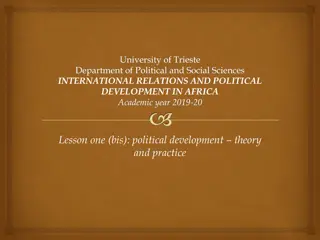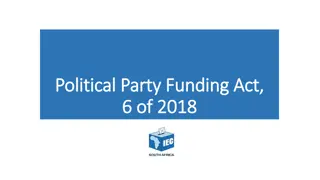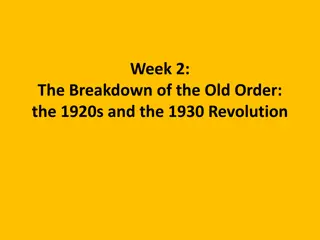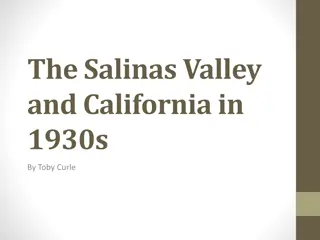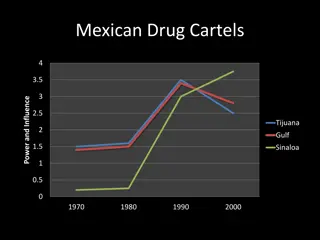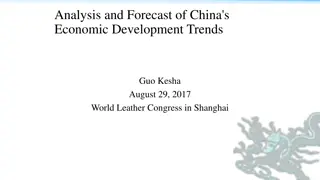Political and Economic Trends in the US: 1930s-2010s Overview
This comprehensive overview covers the fourth political party system in the US from 1932 to 2014, including data on presidential election results, congressional elections, and key economic indicators such as unemployment, GNP, consumer prices, and stock market performance. The content showcases historical information on major political events and economic trends that shaped the country over several decades.
Download Presentation

Please find below an Image/Link to download the presentation.
The content on the website is provided AS IS for your information and personal use only. It may not be sold, licensed, or shared on other websites without obtaining consent from the author. Download presentation by click this link. If you encounter any issues during the download, it is possible that the publisher has removed the file from their server.
E N D
Presentation Transcript
The Fourth Political Party System: 1932 - 2014 Overview
ECONOMICS Unemployment GNP Consumer Prices Manufacturing Investment Stocks 1929 3.2 104.4a 73.3b 58b 16.2c 260.2d 1930 8.7 95.1 71.4 48 10.3 210.3 1931 15.9 89.5 65.0 39 5.5 136.6 1932 23.6 76.4 58.4 30 .9 69.3 1933 24.9 74.2 55.3 36 1.4 89.6 1934 21.7 80.8 57.2 39 2.9 98.4 1935 20.1 91.4 58.7 46 6.3 106.0 1936 16.9 100.9 59.3 55 8.4 154.7 1937 14.3 109.1 61.4 60 11.9 154.1 1938 19.0 103.2 60.3 46 6.7 114.9 1939 17.2 111.0 59.4 57 9.3 120.6 1940 14.6 121.0 59.9 66 13.2 110.2 1941 9.9 138.7 62.9 88 18.1 98.2 a $ Billions in 1929 Prices. b 1947-49 = 100 base c Gross Private Domestic Investment ($ Billions) d Average Prices of Stocks (1941-43 = 100)
Presidential Election Results: 1932 - 2012 1932 Roosevelt 472 22,818,740 57.4 Hoover 59 15,760,425 39.6 1936 Roosevelt 523 27,750,866 60.8 Landon 8 16,679,683 36.5 1940 Roosevelt 449 27,343,218 54.7 Willkie 82 22,334,940 44.8 1944 Roosevelt 432 25,612,610 53.4 Dewey 99 22,021,053 45.9 1948 Truman 303 24,105,810 49.5 Dewey 189 21,970,064 45.1 Thurmond 39 1,169,114 2.4 1952 Stevenson 89 27,314,992 44.4 Eisenhower 442 33,777,945 54.9 1956 Stevenson 73 26,022,752 42.0 Eisenhower 457 35,590,472 57.4 1960 Kennedy 303 34,226,731 49.7 Nixon 219 34,108,157 49.5 1964 Johnson 486 43,129,566 61.1 Goldwater 52 27,178,188 38.5 1968 Humphrey 191 31,275,166 42.7 Nixon 301 31,785,480 43.4 Wallace 46 9,906,473 13.5 1972 McGovern 17 29,170,383 37.5 Nixon 520 47,169,911 60.7 1976 Carter 297 40,830,763 50.1 Ford 240 39,147,793 48.0 1980 Carter 49 35,483,883 41.0 Reagan 489 43,904,153 50.7 Anderson 0 5,720,060 6.6 1984 Mondale 13 37,577,185 40.6 Reagan 525 54,455,075 58.8 1988 Dukakis 111 41,809,074 45.6 Bush,HW 426 48,886,097 53.4 1992 Clinton 370 44,909,326 43.0 Bush,HW 168 39,103,882 37.4 Perot 0 19,741,657 18.9 1996 Clinton 379 47,402,357 49.2 Dole 159 39,198,755 40.7 Perot 0 8,085,402 8.4 2000 Gore 266 50,992,335 48.4 Bush 271 50,455,156 47.9 Nader 0 2,882,738 2.7 2004 Kerry 251 59,026,013 48.3 Bush 286 62,025,554 50.7 2008 Obama 365 69,459,909 52.9 McCain 173 59,930,608 45.7 2012 Obama 332 62,613,406 50.6 Romney 206 59,140,591 47.8
Congressional Elections: 1930 - 2012 HOUSE SENATE Democrat Republican Other Democrat Republican Other 1930 220 214 1 47 48 1 1932 313 117 5 59 36 1 1934 322 103 10 69 25 2 1936 333 89 13 75 17 4 1938 262 169 4 69 23 4 1940 267 162 6 66 28 2 1942 222 209 4 57 38 1 1944 243 190 2 57 38 1 1946 188 246 1 45 51 1948 263 171 1 54 42 1950 234 199 2 48 47 1952 213 221 1 47 48 1 1954 232 203 48 47 1 1956 234 201 49 47 1958 283 154 64 34 1960 263 174 64 36 1962 258 176 1 67 33 1964 295 140 68 32 1966 248 187 64 36 1968 243 192 58 42 1970 255 180 55 45 1972 243 192 57 43 1974 291 144 61 38 1976 292 143 62 38 1978 277 158 59 41 1980 243 192 47 53 1982 269 166 46 54 1984 253 182 47 53 1986 258 177 55 45 1988 259 174 55 45 1990 267 167 1 56 44 1992 258 176 1 57 43 1994 204 230 1 47 53 1996 207 227 1 45 55 1998 211 223 1 45 55 2000 212 221 2 50 50 2002 205 229 1 48 51 1 2004 201 232 1 44 55 1 2006 233 202 50 49 1 2008 256 178 55 41 2 2010 193 242 51 47 2 2012 201 234 53 45 2 -----------------------------------------------------------------------------
The Democrat-Republican Political Party System, 1930 - Late 1930s: Overview 1.The Main Organizing Dimension was Economics -- The Degree of Government Intervention in the Economy 2.The Effect of the Depression was to Shift the Entire Distribution of Voters to the Left on the Existing Dimension. Greater Control over the Economy and Direct Cash Payments to Individuals Became Accepted Policy. 3. The Democrats Became Overwhelmingly Dominate -- The Most Lopsided Two-Party System in American History. Many Scholars Referred to it as a One-and-a-Half Party System.
The Democrat-Republican Political Party System, Late 1930s - Early 1990s: Overview 1. In 1937-38 Voting on the Fair Labor Standards Act (Minimum Wages) Opened a serious Split between Northern and Southern Democrats. Southerners did not want Southern Agriculture to be constrained by the minimum wage because many of the Laborers were Black. 2. During the Second World War Voting on whether or not to Use Federal Law as Opposed to State Law to Determine Voter Eligibility in the Armed Forces Further Exacerbated the Split Between Northern and Southern Democrats. Southern Democrats did not want Blacks serving in the Armed Forces to be able to vote in Southern elections.
3. This conflict culminated in the Passage of the 1964 Civil Rights Act, the 1965 Voting Rights Act, and the 1968 Open Housing Act. Collectively, these laws ended legal segregation. 4. The Passage of the Civil Rights Laws triggered a slow Realignment of the White South into the Republican Party. Aided by President Richard Nixon's "Southern Strategy", the Southern states began voting for Republican Presidential candidates. Eventually Southern States began electing Republican Senators, then Republican Representatives, and finally state and local officials switched to the Republican Party. 5. Economic Growth and In-migration of people and businesses into the Right-to-Work States of the South also had a big role in the switch to the rise of the Republican Party.
The Democrat-Republican Political Party System, Early 1990s - 2014: Overview 1.The Main Organizing Dimension was Economics -- The Degree of Government Intervention in the Economy 2. The Rise of Social/Life-Style Issues 3. Increasing Political and Social Polarization
